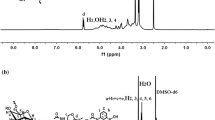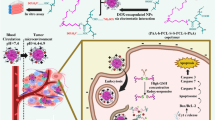Abstract
Purpose
Dynamic carrier-free theranostic nanodrugs are in great demand, owing to their extraordinary high drug loading, enhanced targeting therapy, and panoramic tracking of the drug behaviors. Herein, this work highlights a successful development of pH-triggered dynamic carrier-free nanodrugs for precise tumoral targeting theragnostic, which are established through self-assembly between dasatinib (DAS) and chlorambucil (CLB).
Methods
The study has proved the structure, change in particle size and zeta potential, fluorescence transition, cellular uptake, cytotoxicity as well as biosafety of the carrier-free nanodrugs. The nanodrugs are characterized by Fourier transform infrared spectroscopy, 1H nuclear magnetic resonance, X-ray diffraction, Dynamic light scattering, and Microplate reader. Cellular uptake and cytotoxicity assay are conducted for free drugs and their nanodrugs using tumor cell lines including A549, HepG2, K562, and THP1. ICR mice are applied to evaluate the biosafety of nanodrugs.
Results
The introduction of CLB into DAS nanoparticles can successfully redshift the emission wavelength from 420 to 810 nm. Moreover, the nanodrugs exhibit a dynamic fluorescence intensity conversion via tumoral intracellular gradual quenching of Aggregation-induced emission (AIE). This characteristic is beneficial to the precise monitoring of tumoral intracellular drug behaviors. Furthermore, the nanodrugs show a small-to-large size transition from 175 nm to more than 500 nm in 12 h and surficial charge reversal from −2.3 mV to more than 0.2 mV by protonation at tumoral pHs. These superior properties facilitate the improved cellular uptake and synergistic cytotoxicity on various types of tumor cells.
Conclusion
The study shows that nanodrugs made of DAS and CLB that can self-assemble without carriers under different pH levels may be ready for testing in tumor targeting, and might someday be helpful for diagnosis and treatment in the future.







Similar content being viewed by others
Data Availability
The datasets used in this investigation are accessible for review upon request from the corresponding author of the paper.
References
Xu J, Qin BK, Luan SJ, et al. Acid-labile poly(ethylene glycol) shell of hydrazone-containing biodegradable polymeric micelles facilitating anticancer drug delivery. J Bioact Compat Polym. 2018;33:119–33. https://doi.org/10.1177/0883911517715658.
Liu G-H, Chen T, Zhang X, et al. Small molecule inhibitors targeting the cancers. MedComm. 2022;3:e181. https://doi.org/10.1002/mco2.181.
Zhong L, Li YS, Xiong L, et al. Small molecules in targeted cancer therapy: advances, challenges, and future perspectives. Signal Transduct Target Ther. 2021:6. https://doi.org/10.1038/s41392-021-00572-w.
Li XL, Yu N, Li J, et al. Novel “carrier-free” nanofiber codelivery systems with the synergistic antitumor effect of paclitaxel and tetrandrine through the enhancement of mitochondrial apoptosis. ACS Appl Mater Interfaces. 2020;12:10096–106. https://doi.org/10.1021/acsami.9b17363.
Li X, Li L, Huang Y, et al. Synergistic therapy of chemotherapeutic drugs and MTH1 inhibitors using a pH-sensitive polymeric delivery system for oral squamous cell carcinoma. Biomater Sci. 2017;5:2068–78. https://doi.org/10.1039/c7bm00395a.
Qiao L, Yang H, Gao S, et al. Research progress on self-assembled nanodrug delivery systems. J Mater Chem B. 2022;10:1908–22. https://doi.org/10.1039/d1tb02470a.
Lachota M, Siernicka M, Pilch Z, et al. Dasatinib effect on NK cells and anti-tumor immunity. Blood. 2018:132. https://doi.org/10.1182/blood-2018-99-111280.
Dai J, Zheng H, Huang X, et al. The increase on Th1 and CD8+T levels while a decrease on Treg level after dasatinib treatment indicate a better therapeutic response to dasatinib and deeper clinical remission in chronic myelogenous leukemia patients. Blood. 2019:134. https://doi.org/10.1182/blood-2019-128413.
Venkatesan P. Dasatinib in paediatric chronic myeloid leukaemias. Lancet Oncol. 2018;19:E188. https://doi.org/10.1016/s1470-2045(18)30196-7.
Chen X, Hu Z, Zhou L, et al. Self-assembling a natural small molecular inhibitor that shows aggregation-induced emission and potentiates antitumor efficacy. Nanoscale Horiz. 2021;6:33–42. https://doi.org/10.1039/d0nh00469c.
Zhang RH, Guo HY, Deng H, et al. Piperazine skeleton in the structural modification of natural products: a review. J Enzyme Inhib Med Chem. 2021;36:1165–97. https://doi.org/10.1080/14756366.2021.1931861.
Lipsky AH. N Lamanna, Novel combination approaches with targeted agents in frontline chronic lymphocytic leukemia. Cancer. 2023;129:18–31. https://doi.org/10.1002/cncr.34510.
Heyrman B, Granacher N, Wu KL. Single centre retrospective analysis: transformation of Waldenstrom’s macroglobulinemia to diffuse large B-cell lymphoma. Blood. 2020:136. https://doi.org/10.1182/blood-2020-135822.
Tacconi EMC, Badie S, De Gregoriis G, et al. Chlorambucil targets BRCA1/2-deficient tumours and counteracts PARP inhibitor resistance. EMBO Mol Med. 2019;11 https://doi.org/10.15252/emmm.201809982.
Wang H, Zhang Y, Zeng X, et al. A combined self-assembled drug delivery for effective anti-breast cancer therapy. Int J Nanomedicine. 2021:2373–88. https://doi.org/10.2147/IJN.S299681.
Huang L, Hu S, Y-n F, et al. Multicomponent carrier-free nanodrugs for cancer treatment. J Mater Chem B. 2022;10:9735–54. https://doi.org/10.1039/D2TB02025D.
Chou TC. Drug combination studies and their synergy quantification using the Chou-Talalay method. Cancer Res. 2010;70:440–6. https://doi.org/10.1158/0008-5472.CAN-09-1947.
Dai W, Wang X, Song G, et al. Combination antitumor therapy with targeted dual-nanomedicines. Adv Drug Deliv Rev. 2017;115:23–45. https://doi.org/10.1016/j.addr.2017.03.001.
Kalındemirtaş FD, Kariper İA, Sert E, et al. The evaluation of anticancer activity by synthesizing 5FU loaded albumin nanoparticles by exposure to UV light. Toxicol in Vitro. 2022:84. https://doi.org/10.1016/j.tiv.2022.105435.
Danışman-Kalındemirtaş F, Kariper IA, Erdemir G, et al. Evaluation of anticancer effects of carboplatin-gelatin nanoparticles in different sizes synthesized with newly self-assembly method by exposure to IR light. Sci Rep. 2022:12. https://doi.org/10.1038/s41598-022-15051-7.
Kariper İA, Hepokur C, Danışman-Kalındemirtaş F, et al. A new method for synthesis of carbon nanoparticle and its applications. J Taibah Univ Sci. 2022;16:966–75. https://doi.org/10.1080/16583655.2022.2131996.
Li D, Wei X, Xue W, et al. Size effect of zwitterionic peptide-based nanoscale micelles on cancer therapy. ACS Appl Nano Mater. 2022;5:9344–55. https://doi.org/10.1021/acsanm.2c01665.
Shi Y, van der Meel R, Chen X, et al. The EPR effect and beyond: strategies to improve tumor targeting and cancer nanomedicine treatment efficacy. Theranostics. 2020;10:7921–4. https://doi.org/10.7150/thno.49577.
Liu T, Jin R, Yuan P, et al. Intracellular enzyme-triggered assembly of amino acid-modified gold nanoparticles for accurate cancer therapy with multimode. ACS Appl Mater Interfaces. 2019;11:28621–30. https://doi.org/10.1021/acsami.9b05943.
Ding H, Tan P, Fu S, et al. Preparation and application of pH-responsive drug delivery systems. J Control Release. 2022;348:206–38. https://doi.org/10.1016/j.jconrel.2022.05.056.
Xu S. Y Duan, B Liu, Precise molecular design for high-performance luminogens with aggregation-induced emission. Adv Mater. 2020;32:e1903530. https://doi.org/10.1002/adma.201903530.
Zhang N-Y, Hu X-J, An H-W, et al. Programmable design and self assembly of peptide conjugated AIEgens for biomedical applications. Biomaterials. 2022;287:121655. https://doi.org/10.1016/j.biomaterials.2022.121655.
Sun T, Jiang C. Stimuli-responsive drug delivery systems triggered by intracellular or subcellular microenvironments. Adv Drug Deliv Rev. 2023:114773. https://doi.org/10.1016/j.addr.2023.114773.
Jing X, Hu H, Sun Y, et al. The intracellular and extracellular microenvironment of tumor site: the trigger of stimuli-responsive drug delivery systems. Small. Methods. 2022;6:2101437. https://doi.org/10.1002/smtd.202101437.
Han M, Li Y, Guo Y, et al. Integrative and comprehensive pan-cancer analysis of lymphocyte-specific protein tyrosine kinase in human tumors. Int J Mol Sci. 2022;23:13998. https://doi.org/10.3390/ijms232213998.
Fang Y, Zhang L, Chen Y, et al. Polysaccharides based rapid self-crosslinking and wet tissue adhesive hemostatic powders for effective hemostasis. Carbohydr Polym. 2023;312:120819. https://doi.org/10.1016/j.carbpol.2023.120819.
Sang L, Li J, Zhang F, et al. Glycyrrhetinic acid modified chlorambucil prodrug for hepatocellular carcinoma treatment based on DNA replication and tumor microenvironment. Colloids Surf B: Biointerfaces. 2022;220:112864. https://doi.org/10.1016/j.colsurfb.2022.112864.
Niza E, Nieto-Jiménez C, Noblejas-López MD, et al. Poly (cyclohexene phthalate) nanoparticles for controlled dasatinib delivery in breast cancer therapy. Nanomaterials. 2019;9:1208. https://doi.org/10.3390/nano9091208.
Acknowledgements
We thank the Anhui Medical University and Anhui University for the technical assistance, as well as the staff of the Department of General Surgery, the Second Affiliated Hospital of Bengbu Medical College, and Department of Oncology Surgery, the First Affiliated Hospital of Bengbu Medical College Bengbu.
Funding
This work was supported by the Bengbu Science and Technology Innovation Guidance Project (No. 20220130), the Natural Science Foundation of Anhui Province (No. 2208085MH242), and the Natural Science Key Project of Bengbu Medical College (2021byzd189).
Author information
Authors and Affiliations
Contributions
All authors contributed to the study conception and design. Material preparation, data collection, and analysis were performed by YW, CZ, LC, and SZ. The first draft of the manuscript was written by WF and JM, and all authors commented on previous versions of the manuscript. All authors read and approved the final manuscript.
Corresponding authors
Ethics declarations
Ethical Approval
All authors read and approved the final manuscript.
Conflict of Interest
The authors declare no competing interests.
Additional information
Publisher’s Note
Springer Nature remains neutral with regard to jurisdictional claims in published maps and institutional affiliations.
Supplementary Information
Rights and permissions
Springer Nature or its licensor (e.g. a society or other partner) holds exclusive rights to this article under a publishing agreement with the author(s) or other rightsholder(s); author self-archiving of the accepted manuscript version of this article is solely governed by the terms of such publishing agreement and applicable law.
About this article
Cite this article
Wang, Y., Zhang, C., Zhou, S. et al. pH-Triggered Dynamic Carrier-Free Nanodrugs Self-Assembled from Dasatinib and Chlorambucil with a Potential for Precise Tumoral Targeting Theranostic. J Pharm Innov 18, 2419–2428 (2023). https://doi.org/10.1007/s12247-023-09801-x
Accepted:
Published:
Issue Date:
DOI: https://doi.org/10.1007/s12247-023-09801-x




